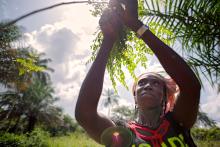Gender inequality and the climate crisis are two of the most urgent challenges of today. As we better understand and make the critical connections between gender, social equity and climate change, it’s time we take action towards solutions.
Five ways to build gender equality and sustainability
From increasing women’s representation in leadership and decision-making to redistributing care-work and productive resources, progress towards a gender equal and sustainable future starts with taking action today.
This International Women’s Day, 8 March, join us in calling for policy and social reforms that put gender equality and sustainability at the centre of progress, starting with these five key ways to drive change.
Empower women smallholders
Over the last few decades, 55 per cent of improvements in food security in developing countries has been driven by programmes promoting women’s economic empowerment. The Food and Agriculture Organization projects that if women smallholders (small-scale farmers who manage agricultural areas up to 10 hectares, or roughly 25 acres) had equal access to productive resources, their farm yields would increase by 20 to 30 per cent. This could provide enough food to keep 100 to 150 million people from going hungry, reducing global hunger by 12 to 17 per cent.
Increasing the productive capacity of women smallholders also helps to promote sustainable agricultural practices. 75 per cent of the world’s food comes from only 12 plants and 5 animal species, making the global food system extremely vulnerable to environmental shocks –– such as changing climate patterns and extreme weather events. Smallholders, who tend to rely on more diverse and climate-resilient crops, represent a sustainable alternative to our current model of agricultural production.
Invest in care
The global economy depends on the unpaid and underpaid care work primarily carried out by women. But despite its essential nature –– which we’ve seen more than ever during the COVID-19 pandemic –– this work is not valued in accordance with its worth. Rather, care work (much like the environment) is treated like a limitless commodity that can be used without cost or consequence.
Instead, governments should treat care work like a collective good, expanding its availability and providing adequate support to those who do it. This includes investing in the expansion of care services, as well as increasing support for unpaid caregivers There’s a role for the private sector as well, in supporting unpaid care work through paid family leave and flexible working arrangements. Investing in care work is not only an acknowledgement of its importance but is also a way to create jobs and foster economic growth without increasing carbon emissions. Care is an inherently sustainable economic sector: rather than consuming resources, it helps to sustain and strengthen human abilities. Curbing emissions will require us to rethink the way we produce and measure value –– moving from a depletion-based economic model to one based on regeneration –– and investing in care is a crucial step in this direction.
Support women’s leadership
Fund women’s organizations
Strong civil society organizations are a critical counterbalance to powerful state and corporate actors. They bring the voices of those who best understand their own experiences and needs into decision-making processes and help to keep governments accountable to the people they are meant to serve –– both key to climate action that prioritizes the wellbeing of people and planet.
Government collaboration with women’s organizations can help ensure that climate policies meet the specific needs of women and girls, and that such policies are effectively implemented. In vulnerable communities, women’s organizations often act as an informal safety net, bridging gaps in government services and helping to provide emergency support. Empowering such community networks is a crucial way to build climate resilience at the local level.
Protect women’s health
Evidence suggests that women will bear the brunt of climate-linked negative health outcomes. In general, women are more likely to die in disasters, due in part to their limited access to resources and services. Research also indicates that climate change will have negative sexual and reproductive health impacts: higher temperatures are increasing the spread of diseases like malaria, dengue fever and Zika virus, which are linked to negative pregnancy and birth outcomes, and extreme heat itself appears to increase the incidence of stillbirth. As with other crises and disasters, climate change also increases vulnerability to gender-based violence.
At the same time, climate disasters often pull resources away from women’s health services and services to support survivors of gender-based violence. As climate change worsens, it is critical that these services are strengthened and expanded to help keep women healthy and safe.
